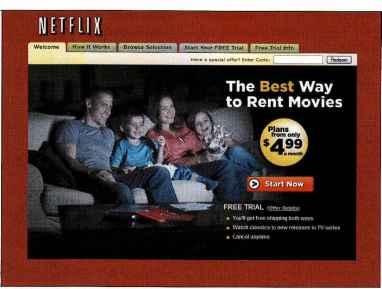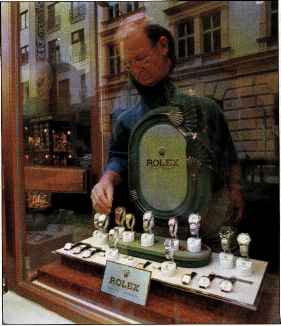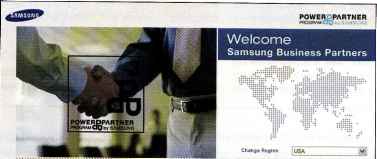Real Erh
Marketing 12.1
Netflix:
Disintermediator or Disintermediated?
Baseball great Yogi Berra, known more for his mangled phrasing than for his baseball prowess, once said, "The future ain't what It used to be." For Netflix, the world's largest online movie-rental sen/ice, no matter how you say it, figuring out the future is challenging and a bit scary. Netflix faces dramatic changes in how movies and other entertainment content will be distributed. The question: Will Netflix be among the disintermediators or among the disintermediated?
Less than a decade ago, if you wanted to watch a movie in the comfort of your own home, your only choice was to roust yourself out of that easy chair and trot down to the local Blockbuster or another neighborhood movie-rental store. In fact, that's how most people still do it. Blockbuster has grown to become the world's largest store-rental chain, with more than 7,800 outlets worldwide and more than $5.5 billion in annual sales.
But now, thanks to Netflix, that distribution model is changing quickly. In the late 1990s, Netflix pioneered a new way to rent movies—via the Web and direct mail. With Netflix, you pay a monthly subscription fee and create a movie wish list online. Netflix mails you a set number of DVDs from your list at a given time, which you can keep for as long as you like. As you return the DVDs in prepaid return envelopes, Netflix automatically sends you new ones from your list.
Netflix offers lots of advantages over the traditional Blockbuster brick-and-mortar system. With store video rentals, you have to make a special trip whenever you want a movie, and if you don't plan ahead, you'll probably find the latest hot releases out of stock. As for finding copies of oldies but goodies, or an old documentary or independent film, forget it—stores can hold only a limited selection of DVDs. Finally, many consumers are frustrated by short due dates and those dreaded late return fees. In contrast, Netflix isn't bound by store-space limitations. It offers a huge selection of more than 90,000 titles and 40 million DVDs total.
The Netflix system eliminates store trips—you always have a stack of DVDs on hand. And there are no per-movie charges, no due dates, and no late fees.
Since first opening its virtual doors, Netflix has continued to add innovative features. Its "dynamic queue" lets customers select as many movie titles as they wish and rank them by preference. Netflix has also developed an online recommendation system, called Cinematch, to help customers find movies they'll love based on their own past ratings, member and critic reviews, and top-rented lists.
As a result, more and more customers are signing up with Netflix. Membership has grown to more than 7.5 million subscribers, and in just the past two years, sales and profits have
Author I Like everything else in Comment | marketing, good channel design begins with analyzing customer needs. Remember, marketing channels are really customer-value delivery networks.
Marketing channel design
Designing effective marketing channels by analyzing consumer needs, setting channel objectives, identifying major channel alternatives, and evaluating them.
Channel Design Decisions (pp 372-376)
We now look at several channel decisions manufacturers face. In designing marketing channels, manufacturers struggle between what is ideal and what is practical. A new firm with limited capital usually starts by selling in a limited market area. Deciding on the best channels might not be a problem: The problem might simply be how to convince one or a few good intermediaries to handle the line.
If successful, the new firm can branch out to new markets through the existing intermediaries. In smaller markets, the firm might sell directly to retailers; in larger markets, it might sell through distributors. In one part of the country, it might grant exclusive franchises; in another, it might sell through all available outlets. Then, it might add a Web store that sells directly to hard-to-reach customers. In this way, channel systems often evolve to meet market opportunities and conditions.
For maximum effectiveness, however, channel analysis and decision making should be more purposeful. Marketing channel design calls for analyzing consumer needs, setting channel objectives, identifying major channel alternatives, and evaluating them.

Welcome
Plans from only surged 77 percent and 60 percent, respectively. Meanwhile, Netflix's success has sent Blockbuster and other video-rental stores reeling. As Netflix sales and profits have soared, Blockbuster's sales have lagged and losses have mounted. The video rental giant has lost money in 10 of the last 11 years. Although the traditional brick-and-mortar video-rental market is still alive and kicking, it's stagnating as the red-hot online channel gains momentum.
To meet the disintermediation threat, Blockbuster introduced its own online videorental service. In fact, Blockbuster Total Access takes the new distribution model one step further. Total Access customers can order videos online and then return or exchange them either through the mail or at their local Blockbuster store. Blockbuster's online business grew quickly to over 2 million subscribers before leveling off. However, for the most part, Blockbuster is still struggling to find the right formula.
And so the video-rental channels battle continues. Blockbuster claims the advantages of a click-and-mortar model that offers both online and store services. In contrast, Netflix sees physical stores as an unnecessary and costly limitation. Says Netflix founder and CEO Reed Hastings, "For people who'd love never to go into a Blockbuster store ever again, we offer better selection, better tools for choosing movies, and more consistent overnight delivery." Either way, there's no going back to the past—the two competitors are rapidly dis-intermediating store-only video-rental outfits.
But just as the present isn't what it used to be, neither is the future. At the same time that Netflix is displacing traditional store channels, it faces its own disintermediation threat from a potentially even hotter channel— digital video distribution in the form of digital downloads and video on demand (VOD). Digital distribution is a fact of life in the music industry, where music download services are fast making traditional CD retailers obsolete. Most experts agree that it's only a matter of time until digital video distribution displaces DVD video sales and rentals.
In fact, it's already begun. These days, you can download all kinds of video entertainment—from movies and TV shows to ads and amateur videos—to your computer, iPod, or even your cell phone. Satellite and cable TV companies are promising VOD services that will let you view movies and other video entertainment on television whenever and wherever you wish. And video-rental download services such as CinemaNow are already offering a growing list of downloadable titles via the Web.
Digital video downloads and video on demand create obvious cost, distribution, and customer convenience advantages over physically producing and distributing DVDs. For sure, the digital video distribution industry still faces problems. Downloading videos can take a lot of time and yields less-than-DVD quality. Perhaps the biggest barrier so far— Hollywood has been cautious about granting video distribution rights, severely limiting the number of available titles. In time, however, all these limitations will likely dissipate. When that happens, it could be lights out for the DVD sales and rental industry.
Netflix CEO Hastings understands the future challenges. "We're sure that we're going to be buying cars in 25 years, whereas renting DVDs through the mail in 25 years— for sure that's not going to exist," he says. The solution? Keep innovating. Instead of simply watching digital video distribution developments, Netflix intends to lead them. Netflix has already added a "watch instantly" feature to its Web site that allows subscribers to instantly stream near-DVD quality video for a limited but growing list of movie titles and TV programs. "Our intention," says Hasting, "is to get [our watch instantly] service to every Internet-connected screen, from cell phones to laptops to Wi-Fi-enabled plasma screens." In this way, Netflix plans to disintermediate its own distribution model before others can do it.
To Hastings, the key to the future is all in how Netflix defines itself. "If [you] think of Netflix as a DVD rental business, [you're] right to be scared," he says. But "if [you] think of Netflix as an online movie service with multiple different delivery models, then [you're] a lot less scared. We're only now starting to deliver [on] that second vision." When asked what Netflix will be like in five years, Hasting responds, "We hope to be much larger, have more subscribers, and be successfully expanding into online video."
Sources: Quotes and other information from Matthew Boyle, "Reed Hastings," Fortune, May 28, 2007, p. 30; Nick Wingfield, "Netflix vs. Naysayers," Wall Street Journal, March 27, 2007, p. B1; Yuval Rosenberg, "What's Next for Netflix?" Fortune, November 29, 2006, p. 172; Paul R. La Monica, "DVD or Download?" CNNMoney.com, June 26, 2006; Nancy Macdonald, "Blockbuster Proves It's Not Dead Yet," Maclean's, March 17, 2008, p. 36; Michael V. Copeland, "Netflix Lives!" Fortune, April 28, 2008, p. 40; "Netflix, Inc.," Hoover's Company Records, April 15, 2008, p. 100752; and Information from www.netflix.com and www.blockbuster.com, accessed November 2008.
Analyzing Consumer Needs
As noted previously, marketing channels are part of the overall customer-value delivery network. Each channel member and level adds value for the customer. Thus, designing the marketing channel starts with finding out what target consumers want from the channel. Do consumers want to buy from nearby locations or are they willing to travel to more distant centralized locations? Would they rather buy in person, by phone, or online? Do they value breadth of assortment or do they prefer specialization? Do consumers want many add-on services (delivery, repairs, installation), or will they obtain these elsewhere? The faster the delivery, the greater the assortment provided, and the more add-on services supplied, the greater the channel's service level.
Providing the fastest delivery, greatest assortment, and most services may not be possible or practical. The company and its channel members may not have the resources or skills needed to provide all the desired services. Also, providing higher levels of service results in higher costs for the channel and higher prices for consumers. The company must balance consumer needs not only against the feasibility and costs of meeting these needs but also against customer price preferences. The success of discount retailing shows that consumers will often accept lower service levels in exchange for lower prices.
Setting Channel Objectives
Companies should state their marketing channel objectives in terms of targeted levels of customer service. Usually, a company can identify several segments wanting different levels of service. The company should decide which segments to serve and the best channels to use in each case. In each segment, the company wants to minimize the total channel cost of meeting customer-service requirements.
The company's channel objectives are also influenced by the nature of the company, its products, its marketing intermediaries, its competitors, and the environment. For example, the company's size and financial situation determine which marketing functions it can handle itself and which it must give to intermediaries. Companies selling perishable products may require more direct marketing to avoid delays and too much handling.
In some cases, a company may want to compete in or near the same outlets that carry competitors' products. In other cases, companies may avoid the channels used by competitors. Mary Kay Cosmetics, for example, sells direct to consumers through its corps of more than one million independent beauty consultants in 34 markets worldwide rather than going head-to-head with other cosmetics makers for scarce positions in retail stores. And GEICO primarily markets auto and homeowner's insurance directly to consumers via the telephone and Web rather than through agents.
Finally, environmental factors such as economic conditions and legal constraints may affect channel objectives and design. For example, in a depressed economy, producers want to distribute their goods in the most economical way, using shorter channels and dropping unneeded services that add to the final price of the goods.
Identifying Major Alternatives
When the company has defined its channel objectives, it should next identify its major channel alternatives in terms of types of intermediaries, the number of intermediaries, and the responsibilities of each channel member.
Types of Intermediaries
A firm should identify the types of channel members available to carry out its channel work. Most companies face many channel member choices. For example, until recently, Dell sold directly to final consumers and business buyers only through its sophisticated phone and Internet marketing channel. It also sold directly to large corporate, institutional, and government buyers using its direct sales force. However, to reach more consumers and to match competitors such as Dell now sells indirectly through retailers such as Best Buy and Wal-Mart. It also sells indirectly through "value-added resellers," independent distributors and dealers who develop computer systems and applications tailored to the special needs of small and medium-sized business customers.
Using many types of resellers in a channel provides both benefits and drawbacks. For example, by selling through retailers and value-added resellers in addition to its own direct channels, Dell can reach more and different kinds of buyers. However, the new channels will be more difficult to manage and control. And the direct and indirect channels will compete with each other for many of the same customers, causing potential conflict. In fact, Dell is already finding itself "stuck in the middle," with its direct sales reps complaining about new competition from retail stores, while at the same time value-added resellers complain that the direct sales reps are undercutting their business.8
Number of Marketing Intermediaries
Companies must also determine the number of channel members to use at each level. Three strategies are available: intensive distribution, exclusive distribution, and selective distribution. Producers of convenience products and common raw materials typically seek
Chapter 12 i Marketing Channels: Delivering Customer Value 375
Intensive distribution
Stocking the product in as many outlets as possible.
Exclusive distribution
Giving a limited number of dealers the exclusive right to distribute the company's products in their territories.

- Exclusive distribution: Rolex sells its watches exclusively through only a handful of authorized dealers in any given market. Such limited distribution enhances the brand's image and generates stronger retailer support.
Selective distribution
The use of more than one, but fewer than all, of the intermediaries who are willing to carry the company's products.
intensive distribution—a strategy in which they stock their products in as many outlets as possible. These products must be available where and when consumers want them. For example, toothpaste, candy, and other similar items are sold in millions of outlets to provide maximum brand exposure and consumer convenience. Kraft, Coca-Cola, Kimberly-Clark, and other consumer-goods companies distribute their products in this way.
By contrast, some producers purposely limit the number of intermediaries handling their products. The extreme form of this practice is exclusive distribution, in which the producer gives only a limited number of dealers the exclusive right to distribute its products in their territories. Exclusive distribution is often found in the distribution of luxury automobiles and prestige women's clothing. A For example, exclusive Rolex watches are typically sold by only a handful of authorized dealers in any given market area. By granting exclusive distribution, Rolex gains stronger dealer selling support and more control over dealer prices, promotion, and services. Exclusive distribution also enhances the brand's image and allows for higher markups.
Between intensive and exclusive distribution lies selective distribution—the use of more than one, but fewer than all, of the intermediaries who are willing to carry a company's products. Most television, furniture, and home appliance brands are distributed in this manner. For example, LG and General Electric sell their major appliances through dealer networks and selected large retailers. By using selective distribution, they can develop good working relationships with selected channel members and expect a better-than-average selling effort. Selective distribution gives producers good market coverage with more control and less cost than does intensive distribution.
Responsibilities of Channel Members
The producer and intermediaries need to agree on the terms and responsibilities of each channel member. They should agree on price policies, conditions of sale, territorial rights, and specific services to be performed by each party. The producer should establish a list price and a fair set of discounts for intermediaries. It must define each channel member's territory, and it should be careful about where it places new resellers.
Mutual services and duties need to be spelled out carefully, especially in franchise and exclusive distribution channels. For example, McDonald's provides franchisees with promotional support, a record-keeping system, training at Hamburger University, and general management assistance. In turn, franchisees must meet company standards for physical facilities and food quality, cooperate with new promotion programs, provide requested information, and buy specified food products.
Evaluating the Major Alternatives
Suppose a company has identified several channel alternatives and wants to select the one that will best satisfy its long-run objectives. Each alternative should be evaluated against economic, control, and adaptive criteria.
Using economic criteria, a company compares the likely sales, costs, and profitability of different channel alternatives. What will be the investment required by each channel alternative, and what returns will result? The company must also consider control issues. Using intermediaries usually means giving them some control over the marketing of the product, and some intermediaries take more control than others. Other things being equal, the company prefers to keep as much control as possible. Finally, the company must apply adaptive criteria. Channels often involve long-term commitments, yet the company wants to keep the channel flexible so that it can adapt to environmental changes. Thus, to be considered, a channel involving long-term commitments should be greatly superior on economic and control grounds.
Designing International Distribution Channels
International marketers face many additional complexities in designing their channels. Each country has its own unique distribution system that has evolved over time and changes very slowly. These channel systems can vary widely from country to country. Thus, global marketers must usually adapt their channel strategies to the existing structures within each country.
In some markets, the distribution system is complex and hard to penetrate, consisting of many layers and large numbers of intermediaries. At the other extreme, distribution systems in developing countries may be scattered, inefficient, or altogether lacking. For example, China and India are huge markets, each with populations well over one billion people. However, because of inadequate distribution systems, most companies can profitably access only a small portion of the population located in each country's most affluent cities. "China is a very decentralized market," notes a China trade expert. "[It's] made up of two dozen distinct markets sprawling across 2,000 cities. Each has its own culture. . . . It's like operating in an asteroid belt." China's distribution system is so fragmented that logistics costs amount to 15 percent of the nation's GDP, far higher than in most other countries. After years of effort, even Wal-Mart executives admit that they have been unable to assemble an efficient supply chain in China.9
Sometimes customs or government regulation can greatly restrict how a company distributes products in global markets. AFor example, it wasn't an inefficient distribution structure that caused problems for Avon in China—it was restrictive government regulations. Fearing the growth of multilevel marketing schemes, the Chinese government banned door-to-door selling altogether in 1998, forcing Avon to abandon its traditional direct marketing approach and sell through retail shops. The Chinese government recently gave Avon and other direct sellers permission to sell door-to-door again, but that permission is tangled in a web of restrictions. Fortunately for Avon, its earlier focus on store sales is helping it weather the restrictions better than most other direct sellers.10
International marketers face a wide range of channel alternatives. Designing efficient and effective channel systems between and within various country markets poses a difficult challenge. We discuss international distribution decisions further in Chapter 19.
Channel Management Decisions (PP 376-379)
Once the company has reviewed its channel alternatives and decided on the best channel design, it must implement and manage the chosen channel. Marketing channel management calls for selecting, managing, and motivating individual channel members and evaluating their performance over time.
Selecting Channel Members
Producers vary in their ability to attract qualified marketing intermediaries. Some producers have no trouble signing up channel members. For example, when Toyota first introduced its Lexus line in the United States, it had no trouble attracting new dealers. In fact, it had to turn down many would-be resellers.
At the other extreme are producers who have to work hard to line up enough qualified intermediaries. For example, when Timex first tried to sell its inexpensive watches through regular jewelry stores, most jewelry stores refused to carry them. The company

- International channel complexities: When the Chinese government banned door-to-door selling, Avon had to abandon its traditional direct marketing approach and sell through retail shops.
Author Now it's time to
Comment | implement the chosen channel design and to work with selected channel members to manage and motivate them.
Marketing channel management
Selecting, managing, and motivating individual channel members and evaluating their performance over time.
then managed to get its watches into mass-merchandise outlets. This turned out to be a wise decision because of the rapid growth of mass-merchandising.
When selecting intermediaries, the company should determine what characteristics distinguish the better ones. It will want to evaluate each channel member's years in business, other lines carried, growth and profit record, cooperativeness, and reputation. If the intermediaries are sales agents, the company will want to evaluate the number and character of other lines carried and the size and quality of the sales force. If the intermediary is a retail store that wants exclusive or selective distribution, the company will want to evaluate the store's customers, location, and future growth potential.
Managing and Motivating Channel Members
Once selected, channel members must be continuously managed and motivated to do their best. The company must sell not only through the intermediaries but to and with them. Most companies see their intermediaries as first-line customers and partners. They practice strong partner relationship management (PRM) to forge long-term partnerships with channel members. This creates a value delivery system that meets the needs of both the companv and its marketing partners. For example, heavy-equipment manufacturer Caterpillar and its worldwide network of independent dealers work in close harmony to find better wa\ 5 to bring value to customers. Dealers play a vital role in almost every aspect of Caterpillar's operations (see Real Marketing 12.2).
In managing its channels, a company must convince distributors that they can succeed better by working together as a part of a cohesive value delivery system. Thus, Procter & Gamble works closely with Wal-Mart to create superior value for final consumers. The two jointly plan merchandising goals and strategies, inventory levels, and advertising and promotion programs. A Similarly, Samsung's Information Technology Division works closely with value-added resellers through the industry-leading Samsung Power Partner Program (P3).
The Samsung P3 program creates close partnerships with important value-added resellers (VARs)—channel firms that assemble IT solutions for their own customers using products from Samsung and other manufacturers. Through the Power Partner Program, Samsung provides extensive presale, selling, and postsale tools and support to some 17,255 registered North America VAR partners at one of three levels-
silver, gold, or platinum. For example, platinum-level partners—those selling $500,000 or more of Samsung IT products per year—receive access to a searchable online product and pricing database and downloadable marketing materials. They can tap into partner-only Samsung training programs, special seminars, and conferences. A dedicated Samsung P3 team helps partners to find good sales prospects and initiate sales. Then, a dedicated Samsung field sales rep works with each partner to close deals, and inside sales reps provide the partner with information and technical support. Platinum partners even participate in Samsung's Reseller Council. Finally, the P3 program rewards high-performing reseller-partners with rebates, discount promotions, bonuses, and sales awards. In all, the Power Partner Program turns important resellers into strong, motivated marketing partners by helping them to be more effective and profitable at selling Samsung.11

See Oîjî Pi weteOE Power ne to the Samsung Partner Program <P3)
It offers ; find new i sales.
vice. By heîpînq i, row ours as we!!. That to bring you our ne1 * Partner Program (P3 5 eiements you need t :ts, and grow yoi
IBliillSSlIIIIIIf.
> Aúd "Power Partner Program'to your browser <* Make "Power Partner Program* Homepage . Link To Samsung Eteetronüee America, BIC, Homepage
Partnering with marketing channel members: The Samsung Power Partner Program turns important resellers into strong, motivated marketing partners by helping them to be more effective and profitable at selling Samsung.

- Caterpillar works closely with its worldwide network of independent dealers to find better ways to bring value to customers. When a big piece of CAT equipment breaks down, customers know they can count on Caterpillar and its outstanding dealer network for support.
Continue reading here: Amount of Service
Was this article helpful?


